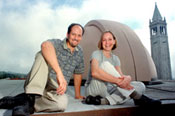Two new
planetary systems are the most bizarre yet found, planet-hunting
team reports
09
Jan 2001
By
Robert Sanders, Media Relations and Andrew Perala, Keck Observatory
|



Professors
Geoff Marcy and Debra Fischer. Noah Berger photo.

|
San Diego
- A team of planet-hunting astronomers announced today (Jan.
9) the discovery of two multi-planet systems that are among
the most bizarre planetary systems found to date.
One system
calls into the question the very meaning of the term "planet,"
said Geoffrey Marcy, professor of astronomy at the University
of California, Berkeley. The second system has two planets
eternally locked in sync, with orbital periods of 60 and 30
days. Both systems were known previously to contain one planet,
but now appear to have two planets each orbiting a central
star.
The discoveries
were reported today at a meeting of the American Astronomical
Society in San Diego. The team that discovered the two stellar
systems include planet sleuths Marcy and Debra Fischer of
the College of Letters & Science at UC Berkeley; staff scientist
Paul Butler of the Carnegie Institution of Washington; Steve
Vogt, professor of astronomy and astrophysics at UC Santa
Cruz; and Jack Lissauer of NASA Ames Research Center in California.
They based their conclusions on observations made at the Keck
I telescope atop Mauna Kea in Hawaii and the Lick Observatory
telescope in California. The work was funded by the National
Aeronautics and Space Administration and the National Science
Foundation.
One of
the systems is around the sun-like star HD 168443, which is
123 light years away in the constellation Serpens. It is orbited
by both a massive planet and another bulkier object at least
17 times more massive than Jupiter, the largest planet orbiting
the Sun. Whether this bulky companion is a planet, a dim failed
star called a brown dwarf or some as-yet unidentified astronomical
object is unclear, said Butler of the Carnegie Institution.
Astronomers are debating the origin and nature of this bulky
beast, and no one is even sure what to call it.
"This massive
planetary object defies our expectations for the largest planets,''
Butler said. "But it's orbiting right there next to another
planet. We never expected nature would make such gargantuan
planets, and indeed maybe they aren't planets at all.''
In a paper
submitted for publication in the Astrophysical Journal, Butler
and Marcy propose that planets can be no larger than the mass
at which deuterium, or heavy hydrogen, would start to burn
in the object's core: about 13 times the mass of Jupiter.
The newly discovered object breaks that barrier, yet calling
it a brown dwarf is too simplistic, Marcy said.
"How did
this form so close in orbit around the star, and in close
association with another planet?" asked Vogt of UC Santa Cruz.
"This is going to bug astronomers."
The two
planets orbiting HD168443 have masses of at least seven and
17 times that of Jupiter. They orbit in eccentric orbits,
as do most planets around other stars, residing 0.3 and 3
A.U. from the star. (One A.U. or astronomical unit is the
distance from the Earth to the Sun: 93 million miles.) The
larger planet wasn't detected until now because the astronomers
needed several years of data in order to see the wobble created
by its 4.7-year orbit.
Around
a second star the team discovered a pair of planets locked
in resonant orbits, moving in synchrony around their star
with orbital periods of 60 and 30 days. Because of this 2-to-1
ratio, the inner planet goes around twice for each orbit of
the outer one. They gravitationally shepherd one another to
maintain this synchrony, their elliptical orbits nested and
aligned like Russian Matrioshka dolls, said Fischer, a post-doctoral
researcher at UC Berkeley.
"These
two resonant planets seem to be humming in harmony," she noted.
"They are like two harmonic notes on a stringed instrument
with commensurate frequencies.''
These two
resonant planets have masses of at least 0.5 and 1.8 the mass
of Jupiter, and orbit Gliese 876, a dim red dwarf star only
15 light years from Earth in the constellation of Aquarius.
The team had enough data on the wobble of Gliese 876 two years
ago to detect the second planet, but the resonant orbits confounded
them. In early December, Marcy sat down to figure out why
the data did not fit perfectly with the model of a single
planet orbiting the star. He decided to model a system with
two planets, and after much trial and error found that two
synchronous orbits with periods in the ratio of 2 to 1 fit
the data best. This is the first known 2-to-1 resonant multi-planet
system.
"We were
fooled," Vogt said. "The synchrony allowed one planet - the
smaller, inner planet - to hide in the wobble of the other."
"Maybe
we have found the music of the planetary spheres,'' Fischer.
"Now we are straining to hear the lyrics, as these planets
are surely telling us something of their birth.''
The research
is part of a multi-year project to look for planets among
1,100 stars within 300 light-years of Earth. The project also
is supported by Sun Microsystems.
###
Links:
American
Astronomical Society
Extrasolar
Planet Search
Keck
Observatory
Lick
Observatory
College
of Letters & Science
Related
Stories:
Finding
worlds like our own
Astronomers
report discovery of three new extrasolar planets, plus hints
of many multi-planet systems
Planet
hunters on trail of worlds smaller than Saturn
.
|